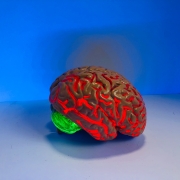Akathisia after chronic usage of synthetic cathinones: A case study
Synthetic cathinones are a heterogenous group of new psychoactive substances (NPS) with a surging prevalence of use. They are sold under the name of “Bath Salts,” “Legal Highs” or “Research Chemical.” It is a heterogeneous group of substances that have a varying binding selectivity and affinity. Due to limited availability of NPS screening tests, inadequate legislation, the exponential increases in availability of new NPS and the comorbid use of other illicit substances, scientific research remains scarce. As a result, insight in their mental and psychomotor effects is limited.
Case description: We present a case of a 21-year-old woman with daily usage of synthetic cathinones, more specifically α-Pyrrolidinopentiophenone (α-PVP-better known as “Flakka”), α-Pyrrolidinohexiophenone (α-PHP) and alpha-Pyrrolidinoisohexaphenone (α-PHiP). Besides a severe paranoid psychotic state of mind, characterized by persecutory and somatic delusions, there was also a very pronounced psychomotor restlessness during the whole period of hospitalization which was diagnosed as akathisia. She reported that she was unable to sit during meals, had difficulty standing still and felt a constant urge to pay attention to the restlessness. The patient did not take any antipsychotic medication at admission.
Results: The patient was treated in accordance with the current guidelines concerning akathisia with a combination of Quetiapine 200 mg, Propranolol 80 mg, Diazepam 10 mg, Biperiden 4 mg, and Mirtazapine 15 mg without any sufficient alleviation of complaints. Before the start of the treatment, Barnes Akathisia Rating Scale (BARS) score was 11 out of 14 which evolved toward a score of 7 over the course of the 40 day hospitalization, implying persisting severe akathisia which only improved modestly.
Conclusion: The current case suggests that besides cocaine, amphetamines and methamphetamines, synthetic cathinones can also increase the risk for development of extrapyramidal symptoms such as akathisia. Especially a-PVP-analogs as used by the current patient and Pyrovalerone-analogs such as Methylenedioxypyrovalerone (MDPV) are very powerful dopamine reuptake-inhibitors which might lead to strong locomotor activation. Up to this day it remains very difficult to establish a guideline concerning the treatment of intoxication with synthetic cathinones or dependence thereof.
You can read the article in full AT THIS LINK.







